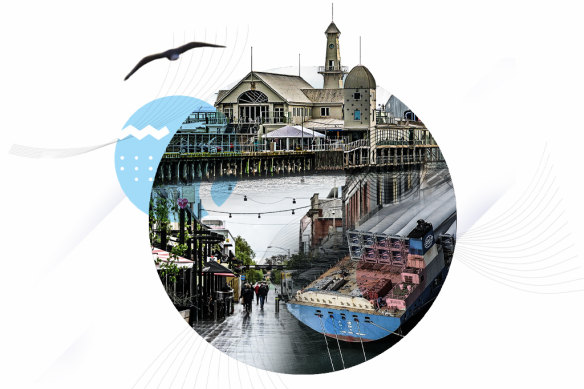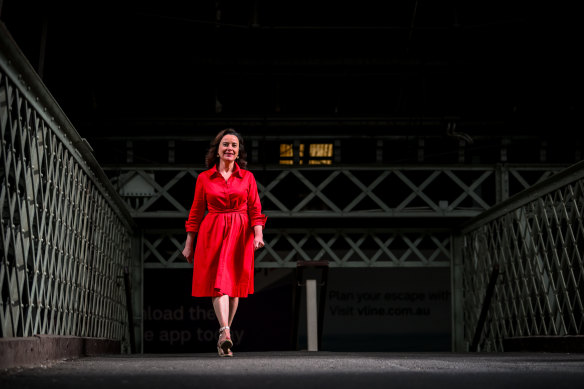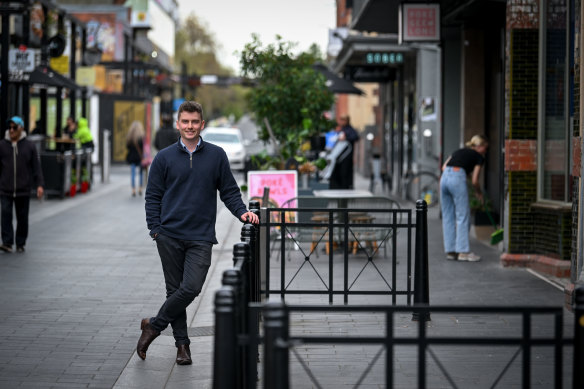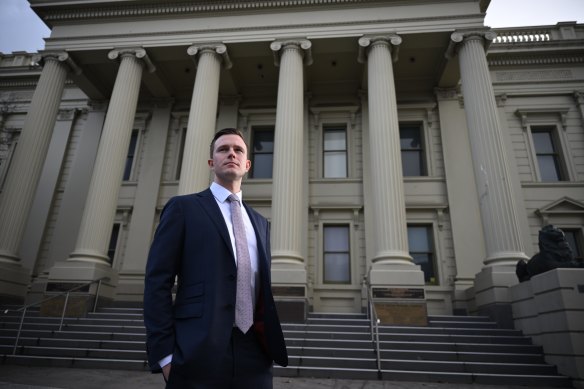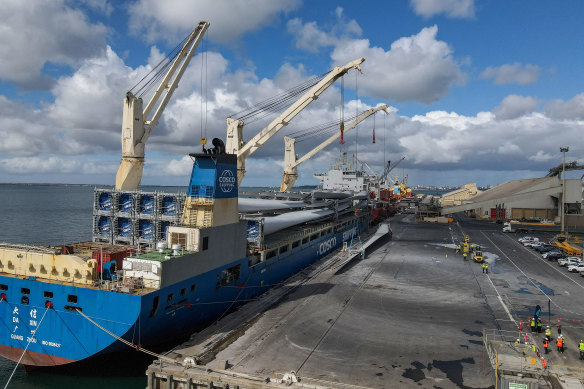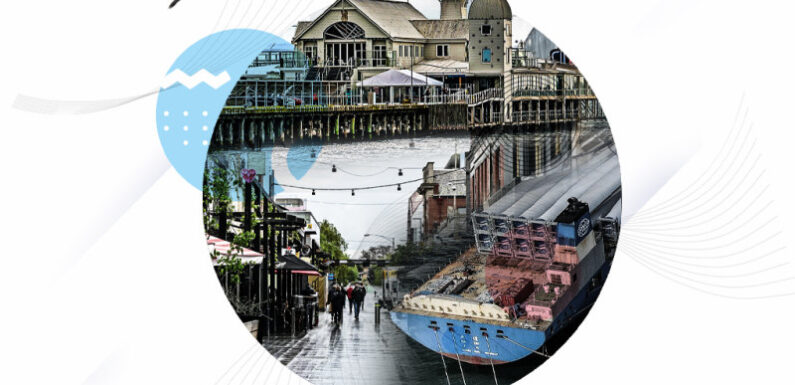
By Benjamin Preiss
Geelong is one of Australia’s fastest-growing cities.Credit: Illustration: Marija Ercegovac
Save articles for later
Add articles to your saved list and come back to them any time.
Cool street art? Yes. Chic coffee roaster? That too. Walk down Little Malop Street in central Geelong, and you’ll be spoilt for choice of restaurants, wine bars, and a brewery nestled in the charming heritage buildings.
This burgeoning urban pocket is seizing its cosmopolitan future, but walk over a main road and the tasteful art gives way to ugly tagging. Vacant shopfront windows are boarded up or covered in dark plastic.
Geelong is among Australia’s fastest-growing regions. Now community leaders want renewal in its CBD and vastly improved infrastructure to match the soaring population.
Metro rail extensions, reducing car lanes to prioritise walking in the CBD and train access to Avalon Airport are some big ideas being proposed to take Geelong into the future.
G21 Regional Alliance chief Giulia Baggio highlights the discrepancy between old and new Geelong.Credit: Eddie Jim
Giulia Baggio, chief executive of G21 Geelong Region Alliance, says some parts of the city centre are thriving, while many others nearby are a handbrake on Geelong’s economic development.
“Side by side, we’ve got new Geelong and old Geelong,” she says.
During the late 1800s, Geelong was among the world’s major wool production centres. The city’s main industry then turned to cars, with Ford establishing a factory in 1925, employing thousands of workers by the 1990s.
But Ford closed its Geelong engine plant in 2010 and shut down all car manufacturing in 2016. Those bleak economic years have given way to a brighter future as an influx of residents and new industries reshape Geelong.
In a series focusing on the imminent transformation of Victoria’s regional cities, The Age is exploring how Geelong, Ballarat, Bendigo and Albury-Wodonga will change in the coming decades.
Although the state government has scrapped plans to hold the 2026 Commonwealth Games in regional Victoria, Baggio still hopes for the rejuvenation of the city centre the event promised to deliver.
The government has said Geelong would receive a new aquatics centre in the suburban growth area of Armstrong Creek and an indoor sports complex at nearby Waurn Ponds, where the proposed athletes’ village was slated to become permanent housing.
When the Games were announced, Baggio was banking on an injection of pride that comes with a chance to shine on the international stage.
“People clean. They polish and get ready. You’ve got sparkling streetscapes. That’s what we had hoped for,” she says.
Yet, Baggio insists it is still possible to rejuvenate the city if it can maintain the momentum it gained before the Games were cancelled.
Magnet for the young
Not only is Greater Geelong’s population booming, it is also getting younger. The population reached almost 283,000 this year, but that’s expected to exceed 396,000 by 2041 and continue climbing as high as 500,000 by 2050.
Baggio says Geelong is experiencing a “youthquake”.
Tim Olifiers, who moved to Geelong in 2020, likes the fact you can get anywhere in under 15 minutes.Credit: Eddie Jim
Census figures show the 18 to 35-year-old age bracket is the fastest growing group in Geelong, rising by 8558 people between 2016 and 2021.
Among them is property analyst Tim Olifiers, 27, who moved to Geelong in early 2020 and now lives in the suburb of Highton with his partner and dog.
He shifted to Geelong because houses were more affordable than in Melbourne. Now he plays golf regularly on several of the region’s courses and spends weekends enjoying the coast. Olifiers sees his future in Geelong, where he plans to raise a family.
“I fell in love with Geelong and the lifestyle,” he says.
Briefly, after the pandemic subsided, Olifiers and his partner moved to Abbotsford, in Melbourne’s inner north. They lasted about six months and shifted back to Geelong.
But he says the city needs to entice more companies to set up offices. In recent years, the Transport Accident Commission, WorkSafe and National Disability Insurance Scheme have all established headquarters in Geelong.
Like many other white-collar workers in Geelong, Olifiers still commutes regularly to Melbourne by train. Initially, he worked five days a week in Melbourne. This year he took a job with a consulting firm that has a small office in Geelong and now travels to Melbourne two days a week.
“A big part of the reason I shifted was because of the commute. It was a burden on me.”
Fast rail delayed
The Geelong Fast Rail project, promised by the former Coalition federal government before the 2019 election, is on ice. The state government also promised $2 billion for the project, but it is now awaiting federal review.
Public Transport Users Association Geelong branch convenor Paul Westcott laughs when asked if Geelong will have a fast train by 2050. “No, I don’t think so,” he says.
Westcott says the Shinkansen bullet trains in Japan, which can reach a top speed of 320 km/h, travel on alignments that separate them from other train services. In Geelong, he says, it is unclear where such tracks could be laid.
Meanwhile, overcrowding and train frequency are the main complaints the association receives from commuters. Westcott wants to see track duplications at Wyndham Vale in Melbourne’s outer west, allowing trains coming from Geelong to bypass outer suburban stations.
Geelong’s growth corridors are expanding rapidly, particularly areas including Armstrong Creek, where the population is forecast to expand from roughly 8840 in 2020 to 25,225 by 2040. In the neighbouring suburb of Mount Duneed, the population is tipped to grow from about 3540 in 2020 to 15,340 in 2040.
Geelong mayor Trent Sullivan wants to see an injection of infrastructure in the growth suburbs, including bike lanes that are separated from cars.
“We need a vast improvement of off-road public transport,” he says.
But Sullivan has a grander vision for getting cars off the road that involves “mass public transport” between Geelong and Torquay.
“It might be train,” he says. “It might be light rail.”
Geelong Mayor Trent Sullivan wants more bike lanes and public transport.Credit: Eddie Jim
There are many other aspirations for Geelong.
RMIT Centre for Urban Research professor Andrew Butt proposes a metro rail system to connect Geelong’s growing suburbs with the city centre and fill transport gaps in the more established suburbs.
In 2021, the state government released a report that canvassed a potential long-term metro concept for Geelong that involved extending the existing train line to Armstrong Creek and Torquay North.
Under this concept, the line would also continue beyond South Geelong with stations at the established suburbs of Thompson, Newcomb and Leopold. There would be new stations, too, at West Geelong, South Lara and Moorabool.
Beyond rail, Butt says it is time to narrow some roads through Geelong’s centre and reduce speed limits to create a more pedestrian-friendly city.
“There’s a big chance to reimagine central Geelong.”
Realising these visions is another matter.
The state government has only committed to far less ambitious transport improvements in Geelong.
It insists it is working with the council to improve pedestrian and bike access in central Geelong, enabling more trains to operate south of the city and completing a project to enhance the Surf Coast Highway.
Jobs boom
On the other side of Greater Geelong, an industrial boom is accompanying the population growth. Here, too, business leaders have been pushing for better public transport, including a train station near Avalon Airport.
The airport’s chief executive Tony Brun says it could be a reality in three years.
“It’s a pretty simple job,” he says. “The rail line is there. We just need to build a station.”
The state government says it has no plans to build a new train station at Avalon, but land has been reserved for a potential rail connection between the airport and the Geelong line.
Meanwhile, on the other side of the city, Avalon Airport is part of a broader industrial precinct that is helping drive Geelong’s economic rise. Figures supplied by the Greater Geelong Council showed the region topped all regional cities (with a population over 40,000) for jobs growth, with the creation of 12,100 positions created last year alone.
Brun says Avalon Airport’s industrial precinct now provides more than 2000 jobs, with Cotton On, Australia Post and Petstock all setting up distribution centres at the site.
Korean company Hanwha Defense Australia is also building its $170 million Armoured Vehicle Centre of Excellence at the Avalon precinct and will manufacture the self-propelled howitzer vehicles and the Redback vehicles as part of the Land 400 Phase 3 project.
“Within the decade, we’ll have north of 5000 jobs and even more within this precinct,” Brun says.
Nearby, GeelongPort is also embarking on an expansion campaign. The port handles 12 million tonnes of cargo each year and provides 1200 direct and indirect jobs, which is forecast to reach 3000 by 2035.
“I would not be surprised at all if that number is 5000 direct and indirect jobs by 2050,” GeelongPort chief executive Brett Winter says.
Wind turbine blades are offloaded from a vessel at the port. Credit: Eddie Jim
He believes the port’s future expansion is linked to the burgeoning renewable energy sector — serving the wind farms in Victoria’s south-west.
The port has released plans to develop 25 hectares of land for a wind farm hub that would be used to house the equipment for towering turbines.
“We see massive potential for Geelong as a renewables hub.”
The port is already handling equipment for the Golden Plains Wind Farm, which will have up to 228 turbines reaching heights of 230 metres.
But Baggio wants Geelong to meet its potential as a major, modern city.
She cites Geelong railway station with its appealing heritage architecture, but grimy and Dickensian interior as symbolic of a city in transition.
Baggio wants to see it upgraded.
“It should be a really spectacular entry point to Geelong,” she says.
A state government planning document for Geelong, released earlier this year, includes the objective of transforming Geelong station into a world-class transport hub.
The document also outlines plans to accommodate 16,000 people in central Geelong by 2050.
In the growing city, Baggio is adamant community enthusiasm and a sense of civic pride that emerged for the Commonwealth Games can still be harnessed after the event was cancelled.
“We now want to gather that energy and put it to good use, because Geelong really needs it.”
The Morning Edition newsletter is our guide to the day’s most important and interesting stories, analysis and insights. Sign up here.
Most Viewed in National
Source: Read Full Article
